Sedimentary Environment Interpretation and Organic Matter Enrichment of the Lower Cambrian Shuijingtuo Shale in the Yichang Slope, South China: Insight from Sedimentary Geochemical Proxies with Major/Trace Elements
Abstract
:1. Introduction
2. Geological Settings
3. Samples and Methods
3.1. Total Organic Carbon Content
3.2. Thin Section Observation
3.3. Major Element Analysis
3.4. Trace Element Analysis
4. Results
4.1. Lithofacies and TOC Content
4.2. Major and Trace Elements
5. Discussion
5.1. Effect of Thermal Diagenesis and Hydrothermal Activity on Element
5.1.1. Thermal Diagenesis Influence
5.1.2. Hydrothermal Activity Influence
5.2. Sedimentary Environments
5.2.1. Redox Condition
5.2.2. Water Mass Restriction
5.2.3. Terrigenous Input and Relative Sea-Level
5.2.4. Paleoproductivity
5.3. Sedimentary Environment of the Shuijingtuo Shale
5.4. Main Factors Controlling Organic Matter Enrichment
6. Conclusions
- The Lower Cambrian Shuijingtuo Shale in the Yichang Slope is divided into three intervals. The lithofacies of interval I is mainly black siliceous shale with high TOC content, and interval II is mainly black siliceous shale with moderate TOC content. Interval III consists of black, clay-rich siliceous shale and dark-gray calcareous shale and is characterized by a low TOC content.
- The major and trace elements in the examined gas-matured samples still retain the geochemical signature of the sedimentary environment, because the thermal diagenesis has little effect on element partitioning or remobilization. This is supported by the strong positive correlations observed between both U/Al and Mo/Al ratios and TOC content. The geochemical indicators used to distinguish between hydrothermal and non-hydrothermal activity reveal that the hydrothermal deposits, which were widely distributed in the southern Yangtze block, were absent in the Yichang Slope.
- Based on the evolution of the sedimentary environment, the primary controlling factors for the organic matter enrichment in the Shuijingtuo Formation at different stages are determined. The high TOC content in the interval I samples is mainly attributed to the strong reducing condition, which was caused by the rapid rise of the relative sea-level in the late Ediacaran to early Cambrian. The subsequent decline in the relative sea-level after the interval II period led to a decrease in oxygen concentration. Additionally, the input of abundant terrigenous debris diluted the original organic matter concentration. Thus, preservation condition and debris dilution together control the organic matter content within the interval II samples. As the relative sea-level continued to fall, the preservation conditions and primary productivity reached lower levels, resulting in lower TOC content in the interval III samples.
Supplementary Materials
Author Contributions
Funding
Institutional Review Board Statement
Informed Consent Statement
Data Availability Statement
Conflicts of Interest
References
- Curtis, J.B. Fractured shale-gas systems. AAPG Bull. 2002, 86, 1921–1938. [Google Scholar]
- Hao, F.; Zou, H.; Lu, Y. Mechanisms of shale gas storage: Implications for shale gas exploration in China. AAPG Bull. 2013, 97, 1325–1346. [Google Scholar] [CrossRef]
- Zou, C.; Yang, Z.; Dong, D.; Zhao, q.; Chen, Z.; Feng, Y.; Li, J.; Wang, X. Formation, distribution and prospect of unconventional hydrocarbons in source rock strata in China. Earth Sci. 2022, 47, 1517–1533. (In Chinese) [Google Scholar]
- Ko, L.T.; Loucks, R.G.; Zhang, T.; Ruppel, S.C.; Shao, D. Pore and pore network evolution of Upper Cretaceous Boquillas (Eagle Ford-equivalent) mudrocks: Results from gold tube pyrolysis experiments. AAPG Bull. 2016, 100, 1693–1722. [Google Scholar] [CrossRef]
- Loucks, R.G.; Reed, R.M.; Ruppel, S.C.; Jarvie, D.M. Morphology, genesis, and distribution of nanometer-scale pores in siliceous mudstones of the Mississippian Barnett Shale. J. Sediment. Res. 2009, 79, 848–861. [Google Scholar] [CrossRef]
- Wei, S.; He, S.; Pan, Z.; Zhai, G.; Yang, R.; Dong, T.; Yang, W. Characteristics and evolution of pyrobitumen-hosted pores of the overmature Lower Cambrian Shuijingtuo Shale in the south of Huangling anticline, Yichang area, China: Evidence from FE-SEM petrography. Mar. Petrol. Geol. 2020, 116, 104303. [Google Scholar] [CrossRef]
- Sageman, B.B.; Murphy, A.E.; Werne, J.P.; Ver Straeten, C.A.; Hollander, D.J.; Lyons, T.W. A tale of shales: The relative roles of production, decomposition, and dilution in the accumulation of organic-rich strata, Middle–Upper Devonian, Appalachian basin. Chem. Geol. 2003, 195, 229–273. [Google Scholar] [CrossRef]
- Katz, B.J. Controlling Factors on Source Rock Development—A Review of Productivity, Preservation, and Sedimentation Rate. In The Deposition of Organic-Carbon-Rich Sediments: Models, Mechanisms, and Consequences; SEPM Society for Sedimentary Geology: Broken Arrow, OK, USA, 2005; Volume 82, pp. 7–16. [Google Scholar]
- Zhao, J.; Jin, Z.; Jin, Z.; Geng, Y.; Wen, X.; Yan, C. Applying sedimentary geochemical proxies for paleoenvironment interpretation of organic-rich shale deposition in the Sichuan Basin, China. Int. J. Coal Geol. 2016, 163, 52–71. [Google Scholar] [CrossRef]
- Algeo, T.J.; Maynard, J.B. Trace-element behavior and redox facies in core shales of Upper Pennsylvanian Kansas-type cyclothems. Chem. Geol. 2004, 206, 289–318. [Google Scholar] [CrossRef]
- Harris, N.B. The Deposition of Organic-Carbon-Rich Sediments: Models, Mechanisms, and Consequences—Introduction; SEPM Society for Sedimentary Geology: Broken Arrow, OK, USA, 2005; Volume 82. [Google Scholar]
- Bohacs, K.M.; Grabowski, G.J.; Carroll, A.R., Jr.; Mankiewicz, P.J.; Miskell-Gerhardt, K.J.; Schwalbach, J.R.; Wegner, M.B.; Simo, J.A. Production, Destruction, and Dilution—The Many Paths to Source-Rock Development. In The Deposition of Organic-Carbon-Rich Sediments: Models, Mechanisms, and Consequences; SEPM Society for Sedimentary Geology: Broken Arrow, OK, USA, 2005; Volume 82. [Google Scholar]
- Rimmer, S.M.; Thompson, J.A.; Goodnight, S.A.; Robl, T.L. Multiple controls on the preservation of organic matter in Devonian–Mississippian marine black shales: Geochemical and petrographic evidence. Palaeogeogr. Palaeoclimatol. Palaeoecol. 2004, 215, 125–154. [Google Scholar] [CrossRef]
- Wei, C.; Dong, T.; He, Z.; He, S.; He, Q.; Yang, R.; Guo, X.; Hou, Y. Major, trace-elemental and sedimentological characterization of the upper Ordovician Wufeng-lower Silurian Longmaxi formations, Sichuan Basin, south China: Insights into the effect of relative sea-level fluctuations on organic matter accumulation in shales. Mar. Petrol. Geol. 2021, 126, 104905. [Google Scholar] [CrossRef]
- Shen, W.; Wang, Y.; Zheng, Z.; Shen, S.; Xie, H.; Qin, H.; Bai, M. Paleo-Environmental Variation and Its Control on the Organic Matter Accumulation in Black Shale of the Permian Gufeng Formation in the Lower Yangtze Area, South China. Front. Earth Sci. 2022, 10, 899947. [Google Scholar] [CrossRef]
- Canfield, D.E. Factors influencing organic carbon preservation in marine sediments. Chem. Geol. 1994, 114, 315–329. [Google Scholar] [CrossRef] [PubMed]
- Chen, L.; Zhang, B.; Chen, X.; Jiang, S.; Zhang, G.; Lin, W.; Chen, P.; Liu, Z. Depositional environment and organic matter accumulation of the Lower Cambrian Shuijingtuo Formation in the middle Yangtze area, China. J. Petrol. Sci. Eng. 2022, 208, 109339. [Google Scholar] [CrossRef]
- Ibach, L.E.J. Relationship Between Sedimentation Rate and Total Organic Carbon Content in Ancient Marine Sediments1. AAPG Bull. 1982, 66, 170–188. [Google Scholar]
- Liu, Z.; Xu, L.; Wen, Y.; Zhang, Y.; Luo, F.; Duan, K.; Chen, W.; Zhou, X.; Wen, J. Accumulation characteristics and comprehensive evaluation of shale gas in Cambrian Niutitang Formation, Hubei. Earth Sci. 2022, 47, 1586–1603. (In Chinese) [Google Scholar]
- Chen, X.; Chen, L.; Jiang, S.; Liu, A.; Luo, S.; Li, H.; Li, P.; Chen, P. Evaluation of shale reservoir quality by geophysical logging for Shuijingtuo Formation of Lower Cambrian in Yichang area, central Yangtze. J. Earth Sci. 2021, 32, 766–777. [Google Scholar] [CrossRef]
- Wang, Y.; Zhai, G.; Liu, G.; Shi, W.; Lu, Y.; Li, J.; Zhang, Y. Geological characteristics of shale gas in different strata of marine facies in South China. J. Earth Sci. 2021, 32, 725–741. [Google Scholar] [CrossRef]
- Zhang, T.; Luo, H.; Meng, K. Discussion on main controlling factors of the differences of gas content for Cambrian shale in different regions of South China. Earth Sci. Front. 2023, 30, 1–13. (In Chinese) [Google Scholar]
- Wei, S.; Hu, M.; He, S.; Shu, Y.; Dong, T.; He, Q.; Yang, W.; Cai, Q. Effects of Quartz Precipitation on the Abundance and Preservation of Organic Matter Pores in Cambrian Marine Shale in South China. J. Mar. Sci. Eng. 2023, 11, 1267. [Google Scholar] [CrossRef]
- Yang, W.; He, S.; Zhai, G.; Tao, Z.; Yuan, X.; Wei, S. Maturity assessment of the Lower Cambrian and Sinian shales using multiple technical approaches. J. Earth Sci. 2021, 32, 1262–1277. [Google Scholar] [CrossRef]
- Meng, M.; Ge, H.; Shen, Y.; Ji, W.; Li, Z. Insight into water occurrence and pore size distribution by nuclear magnetic resonance in marine shale reservoirs, southern China. Energy Fuels 2023, 37, 319–327. [Google Scholar] [CrossRef]
- Li, Z.X.; Bogdanova, S.V.; Collins, A.S.; Davidson, A.; De Waele, B.; Ernst, R.E.; Fitzsimons, I.C.W.; Fuck, R.A.; Gladkochub, D.P.; Jacobs, J.; et al. Assembly, configuration, and break-up history of Rodinia: A synthesis. Precambrian Res. 2008, 160, 179–210. [Google Scholar] [CrossRef]
- Jiang, G.; Wang, X.; Shi, X.; Xiao, S.; Zhang, S.; Dong, J. The origin of decoupled carbonate and organic carbon isotope signatures in the early Cambrian (ca. 542–520 Ma) Yangtze platform. Earth Planet. Sci. Lett. 2012, 317–318, 96–110. [Google Scholar] [CrossRef]
- Wang, Z.; Tan, J.; Hilton, J.; Dick, J.; Wen, Z. Trace element enrichment mechanisms in black shales during the early cambrian (ca. 521–514 Ma), South China. Mar. Petrol. Geol. 2023, 149, 106083. [Google Scholar] [CrossRef]
- Tribovillard, N.; Algeo, T.J.; Lyons, T.; Riboulleau, A. Trace metals as paleoredox and paleoproductivity proxies: An update. Chem. Geol. 2006, 232, 12–32. [Google Scholar] [CrossRef]
- Taylor, S.R.; McLennan, S.M. The Continental Crust: Its Composition and Evolution. 1985. Available online: https://www.osti.gov/biblio/6582885 (accessed on 17 October 2023).
- Ross, D.J.K.; Bustin, R.M. Investigating the use of sedimentary geochemical proxies for paleoenvironment interpretation of thermally mature organic-rich strata: Examples from the Devonian–Mississippian shales, Western Canadian Sedimentary Basin. Chem. Geol. 2009, 260, 1–19. [Google Scholar] [CrossRef]
- Abanda, P.A.; Hannigan, R.E. Effect of diagenesis on trace element partitioning in shales. Chem. Geol. 2006, 230, 42–59. [Google Scholar] [CrossRef]
- Raiswell, R.; Berner, R.A. Organic carbon losses during burial and thermal maturation of normal marine shales. Geology. 1987, 15, 853–856. [Google Scholar] [CrossRef]
- Steiner, M.; Wallis, E.; Erdtmann, B.-D.; Zhao, Y.; Yang, R. Submarine-hydrothermal exhalative ore layers in black shales from South China and associated fossils—Insights into a Lower Cambrian facies and bio-evolution. Palaeogeogr. Palaeoclimatol. Palaeoecol. 2001, 169, 165–191. [Google Scholar] [CrossRef]
- Zhang, K.; Li, X.; Wang, Y.; Liu, W.; Yu, Y.; Zhou, L.; Feng, W. Paleo-environments and organic matter enrichment in the shales of the Cambrian Niutitang and Wunitang Formations, south China: Constraints from depositional environments and geochemistry. Mar. Petrol. Geol. 2021, 134, 105329. [Google Scholar] [CrossRef]
- Zhang, K.; Jiang, Z.; Yin, L.; Gao, Z.; Wang, P.; Song, Y.; Jia, C.; Liu, W.; Liu, T.; Xie, X.; et al. Controlling functions of hydrothermal activity to shale gas content-taking lower Cambrian in Xiuwu Basin as an example. Mar. Petrol. Geol. 2017, 85, 177–193. [Google Scholar] [CrossRef]
- Li, Y.; Fan, T.; Zhang, J.; Zhang, J.; Wei, X.; Hu, X.; Zeng, W.; Fu, W. Geochemical changes in the Early Cambrian interval of the Yangtze Platform, South China: Implications for hydrothermal influences and paleocean redox conditions. J. Asian Earth Sci. 2015, 109, 100–123. [Google Scholar] [CrossRef]
- Wang, Z.; Tan, J.; Boyle, R.; Hilton, J.; Ma, Z.; Wang, W.; Lyu, Q.; Kang, X.; Luo, W. Evaluating episodic hydrothermal activity in South China during the early Cambrian: Implications for biotic evolution. Mar. Petrol. Geol. 2020, 117, 104355. [Google Scholar] [CrossRef]
- Boström, K.; Peterson, M.N.A. The origin of aluminum-poor ferromanganoan sediments in areas of high heat flow on the East Pacific Rise. Mar. Geol. 1969, 7, 427–447. [Google Scholar] [CrossRef]
- Yamamoto, K. Geochemical characteristics and depositional environments of cherts and associated rocks in the Franciscan and Shimanto Terranes. Sediment Geol. 1987, 52, 65–108. [Google Scholar] [CrossRef]
- Cai, Q.; Hu, M.; Kane, O.I.; Li, M.; Zhang, B.; Hu, Z.; Deng, Q.; Xing, N. Cyclic variations in paleoenvironment and organic matter accumulation of the Upper Ordovician–Lower Silurian black shale in the Middle Yangtze Region, South China: Implications for tectonic setting, paleoclimate, and sea-level change. Mar. Petrol. Geol. 2021, 136, 105477. [Google Scholar] [CrossRef]
- Dong, T.; He, Q.; He, S.; Zhai, G.; Zhang, Y.; Wei, S.; Wei, C.; Hou, Y.; Guo, X. Quartz types, origins and organic matter-hosted pore systems in the lower cambrian Niutitang Formation, middle yangtze platform, China. Mar. Petrol. Geol. 2021, 123, 104739. [Google Scholar] [CrossRef]
- Adachi, M.; Yamamoto, K.; Sugisaki, R. Hydrothermal chert and associated siliceous rocks from the northern Pacific their geological significance as indication od ocean ridge activity. Sediment Geol. 1986, 47, 125–148. [Google Scholar] [CrossRef]
- Halbach, M.; Halbach, P.; Lüders, V. Sulfide-impregnated and pure silica precipitates of hydrothermal origin from the Central Indian Ocean. Chem. Geol. 2002, 182, 357–375. [Google Scholar] [CrossRef]
- Zhang, Y.; Huang, D.; Zhang, L.; Wan, C.; Luo, H.; Shao, D.; Meng, K.; Yan, J.; Zhang, T. Biogenic silica of the Lower Cambrian Shuijingtuo Formation in Yichang, western Hubei Province—Features and influence on shale gas accumulation. Earth Sci. Front. 2023, 30, 83–100. (In Chinese) [Google Scholar]
- Luo, H.; Shao, D.; Meng, K.; Zhang, Y.; Song, H.; Yan, J.; Zhang, T. Origin of excess barium in the Cambrian shale of Yichang area, western Hubei, and its implication for organic matter accumulation. Earth Sci. Front. 2023, 30, 66–82. (In Chinese) [Google Scholar]
- Wei, K.; Chen, X.; Wang, C.; Liu, A.; Zeng, X.; Li, Z. Origin of siliceous rocks in west Hunan and Hubei Provinces during Late Ediacaran-Early Cambrian, and its geological significance of shale gas. Bull. Geol. Sci. Technol. 2020, 39, 20–30. (In Chinese) [Google Scholar]
- Jones, B.; Manning, D.A.C. Comparison of geochemical indices used for the interpretation of palaeoredox conditions in ancient mudstones. Chem. Geol. 1994, 111, 111–129. [Google Scholar] [CrossRef]
- Gambacorta, G.; Trincianti, E.; Torricelli, S. Anoxia controlled by relative sea-level changes: An example from the Mississippian Barnett Shale Formation. Palaeogeogr. Palaeoclimatol. Palaeoecol. 2016, 459, 306–320. [Google Scholar] [CrossRef]
- Zhao, L.; Liu, S.; Li, G.; Zhang, M.; Liang, X.; Li, J.; Xu, J. Sedimentary Environment and Enrichment of Organic Matter During the Deposition of Qiongzhusi Formation in the Upslope Areas—A Case Study of W207 Well in the Weiyuan Area, Sichuan Basin, China. Front. Earth Sci. 2022, 10, 867616. [Google Scholar] [CrossRef]
- Hoefs, J. Stable Isotope Geochemistry; Springer: Berlin/Heidelberg, Germany, 1997; Volume 201. [Google Scholar]
- Algeo, T.J.; Ingall, E. Sedimentary Corg:P ratios, paleocean ventilation, and Phanerozoic atmospheric pO2. Palaeogeogr. Palaeoclimatol. Palaeoecol. 2007, 256, 130–155. [Google Scholar] [CrossRef]
- Ingall, E.; Kolowith, L.; Lyons, T.; Hurtgen, M. Sediment carbon, nitrogen and phosphorus cycling in an anoxic fjord, Effingham Inlet, British Columbia. Am. J. Sci. 2005, 305, 240–258. [Google Scholar] [CrossRef]
- Sannigrahi, P.; Ingall, E. Polyphosphates as a source of enhanced P fluxes in marine sediments overlain by anoxic waters: Evidence from 31P NMR. Geochem. Trans. 2005, 6, 52–59. [Google Scholar] [CrossRef]
- Luo, S.; Chen, X.; Li, H.; Wang, C. Shale gas accumulation conditions and target optimization of the Lower Cambrian Shuijintuo Formation in Yichang area, Western Hubei. Earth Sci. 2019, 44, 3598–3615. (In Chinese) [Google Scholar]
- Algeo, T.J.; Tribovillard, N. Environmental analysis of paleoceanographic systems based on molybdenum–uranium covariation. Chem. Geol. 2009, 268, 211–225. [Google Scholar] [CrossRef]
- Tribovillard, N.; Algeo, T.J.; Baudin, F.; Riboulleau, A. Analysis of marine environmental conditions based onmolybdenum–uranium covariation—Applications to Mesozoic paleoceanography. Chem. Geol. 2012, 324–325, 46–58. [Google Scholar] [CrossRef]
- Zhang, G.; Chen, D.; Ding, Y.; Huang, T. Controls on Organic Matter Accumulation from an Upper Slope Section on the Early Cambrian Yangtze Platform, South China. Minerals 2023, 13, 260. (In Chinese) [Google Scholar] [CrossRef]
- Yang, X.; Yan, D.; Zhang, B.; Zhang, L.; Wei, X.; Li, T.; Zhang, J.; She, X. The impact of volcanic activity on the deposition of organic-rich shales: Evidence from carbon isotope and geochemical compositions. Mar. Petrol. Geol. 2021, 128, 105010. [Google Scholar] [CrossRef]
- Shu, Y.; Lu, Y.; Hu, Q.; Wang, C.; Wang, Q. Geochemical, petrographic and reservoir characteristics of the transgressive systems tract of lower Silurian black shale in Jiaoshiba area, southwest China. Mar. Petrol. Geol. 2021, 129, 105014. [Google Scholar] [CrossRef]
- Shen, W.; Zhu, X.; Li, J.; Yan, B. Mechanism of organic matter accumulation in black shale of the Datangpo Formation: Insights from paleo-environmental variation during the Cryogenian non-glaciation. Precambrian Res. 2022, 383, 106889. [Google Scholar] [CrossRef]
- Rimmer, S.M. Geochemical paleoredox indicators in Devonian–Mississippian black shales, Central Appalachian Basin (USA). Chem. Geol. 2004, 206, 373–391. [Google Scholar] [CrossRef]
- Thibault, N.; Ruhl, M.; Ullmann, C.V.; Korte, C.; Kemp, D.B.; Gröcke, D.R.; Hesselbo, S.P. The wider context of the Lower Jurassic Toarcian oceanic anoxic event in Yorkshire coastal outcrops, UK. Proc. Geol. Assoc. 2018, 129, 372–391. [Google Scholar] [CrossRef]
- Yi, F.; Yi, H.; Xia, G.; Wu, C.; Li, G.; Cai, Z.; Li, N. Factors controlling the organic matter accumulation across the Pliensbachian-Toarcian transition in the Qiangtang Basin, Tibetan Plateau. Mar. Petrol. Geol. 2021, 133, 105304. [Google Scholar] [CrossRef]
- Dong, T.; Harris, N.B.; Knapp, L.J.; McMillan, J.M.; Bish, D.L. The effect of thermal maturity on geomechanical properties in shale reservoirs: An example from the Upper Devonian Duvernay Formation, Western Canada Sedimentary Basin. Mar. Petrol. Geol. 2018, 97, 137–153. [Google Scholar] [CrossRef]
- Cai, Q.; Hu, M.; Kane, O.I.; Yang, Z.; Wen, Y.; Luo, Q.; Li, M.; Hu, Z.; Deng, Q. Petrological and geochemical characteristics of the Ordovician–Silurian black shale in eastern Sichuan and western Hubei, South China: Differential sedimentary responses to tectonism and glaciation. J. Palaeogeogr. 2023, 12, 129–152. [Google Scholar] [CrossRef]
- Worden, R.H.; Morad, S. Quartz cementation in oil field sandstones: A review of the key controversies. In Quartz Cementation in Sandstones; Worden, R.H., Morad, S., Eds.; Blackwell Science: Hoboken, NJ, USA, 2000; pp. 1–20. [Google Scholar]
- Rutman, P.; Hoareau, G.; Kluska, J.-M.; Lejay, A.; Fialips, C.; Gelin, F.; Aubourg, C.; Bilbao, E.H. Diagenesis and alteration of subsurface volcanic ash beds of the Vaca Muerta Formation, Argentina. Mar. Petrol. Geol. 2021, 132, 105220. [Google Scholar] [CrossRef]
- Dong, T.; Harris, N.B.; Ayranci, K.; Yang, S. The impact of rock composition on geomechanical properties of a shale formation: Middle and Upper Devonian Horn River Group shale, Northeast British Columbia, Canada. AAPG Bull. 2017, 101, 177–204. [Google Scholar] [CrossRef]
- Zhao, J.; Jin, Z.; Lin, C.; Liu, G.; Liu, K.; Liu, Z.; Zhang, Y. Sedimentary environment of the Lower Cambrian Qiongzhusi Formation shale in the Upper Yangtze region. Oil Gas Geol. 2019, 40, 701–715. (In Chinese) [Google Scholar]
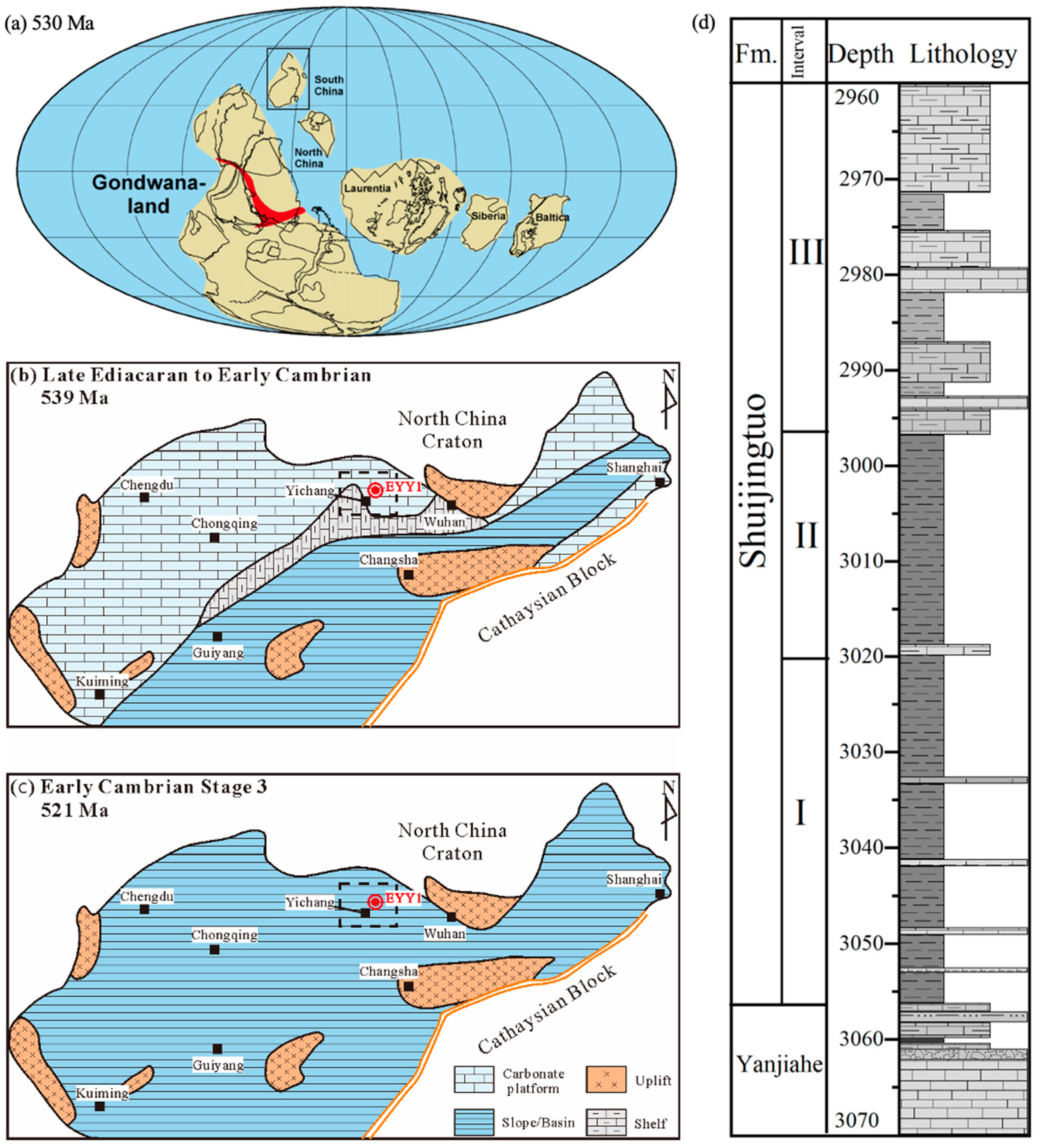
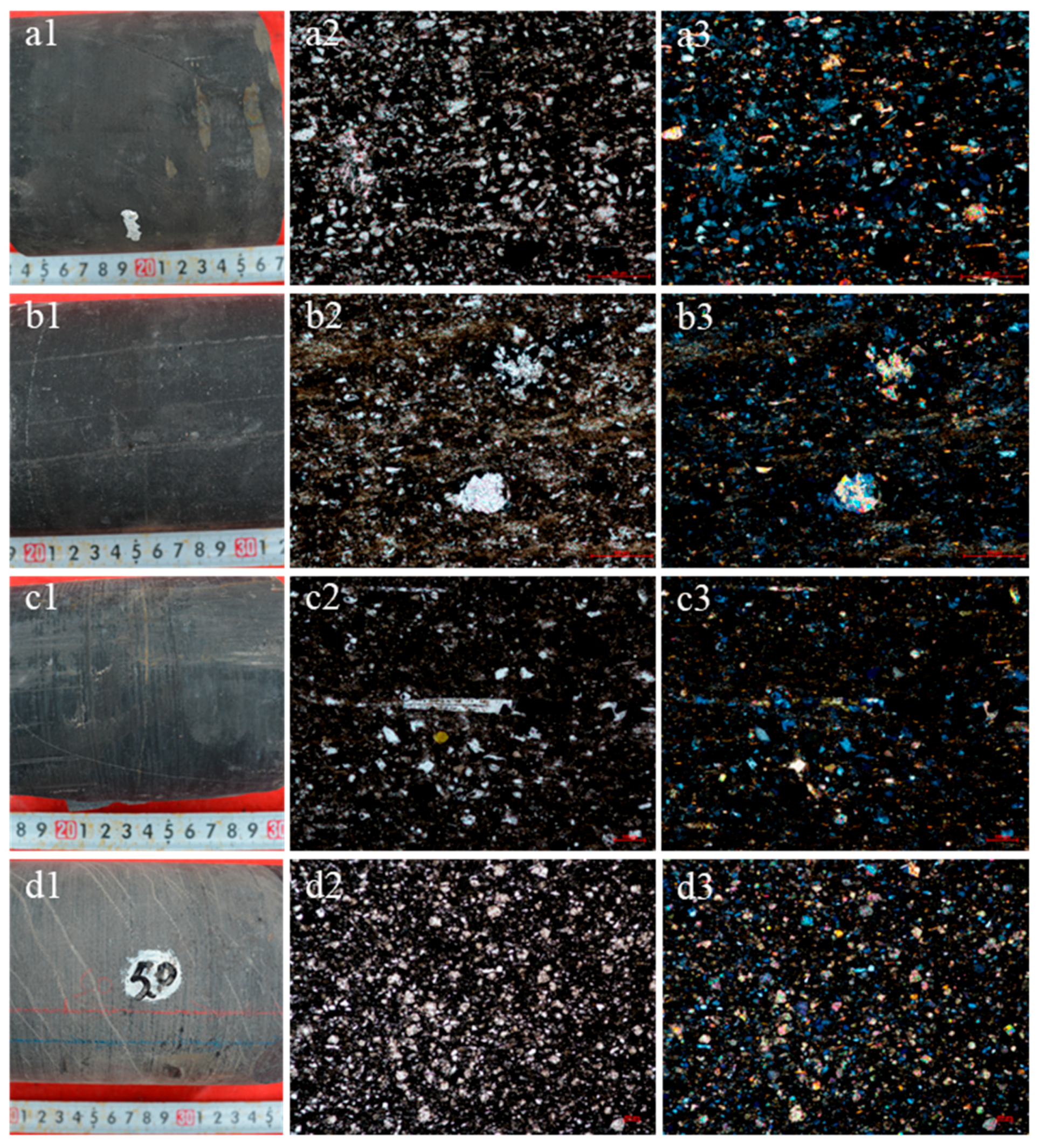



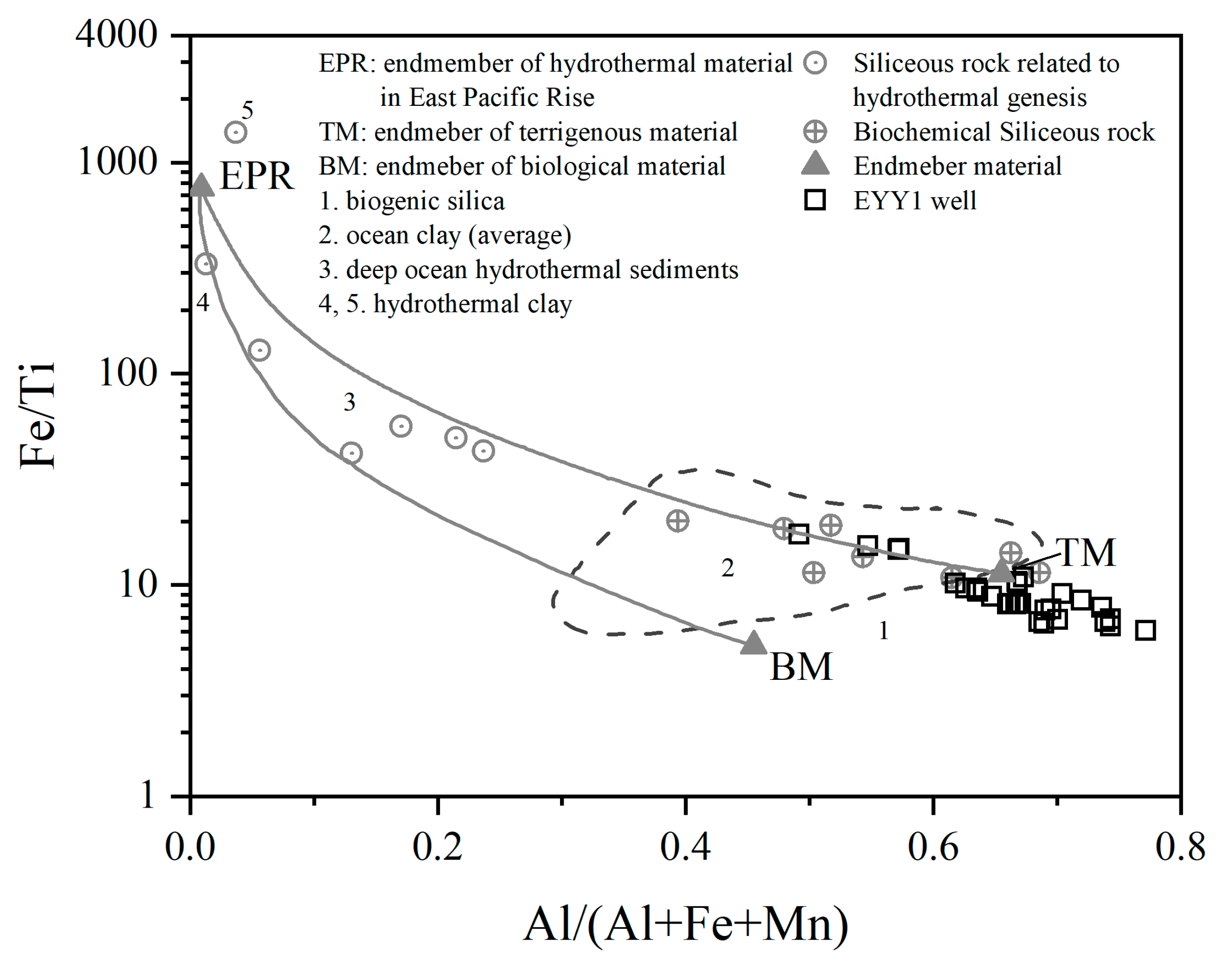
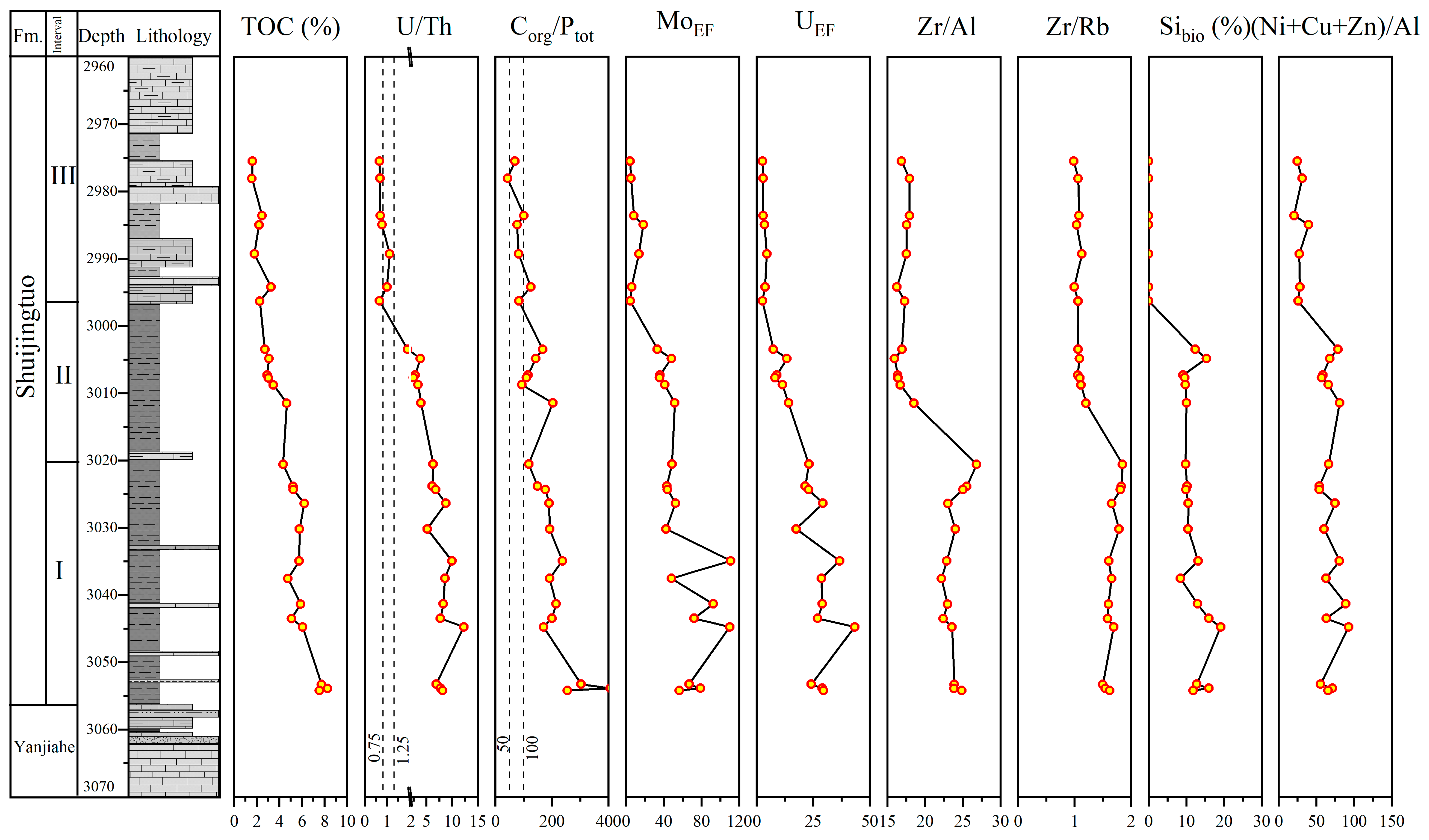
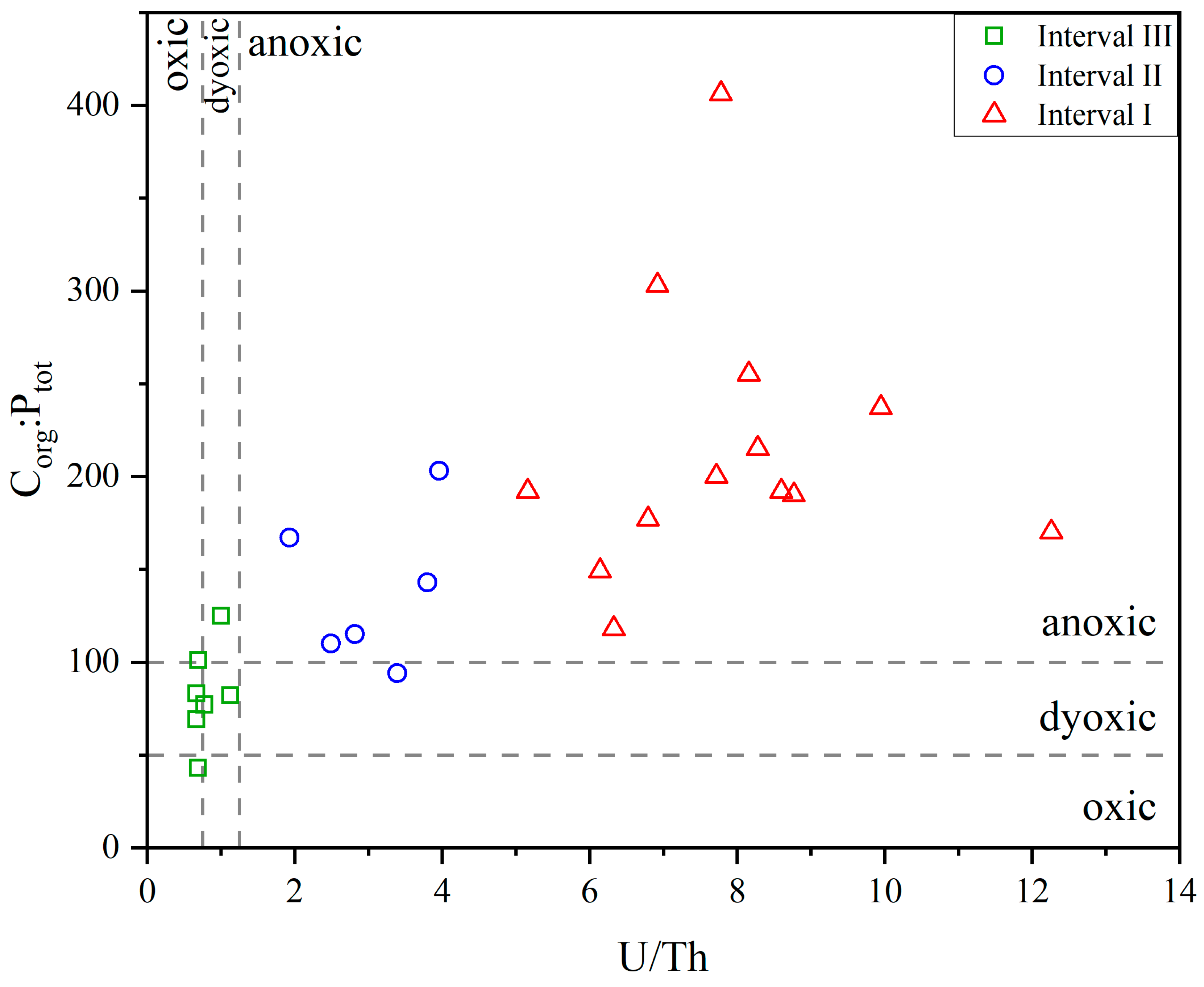
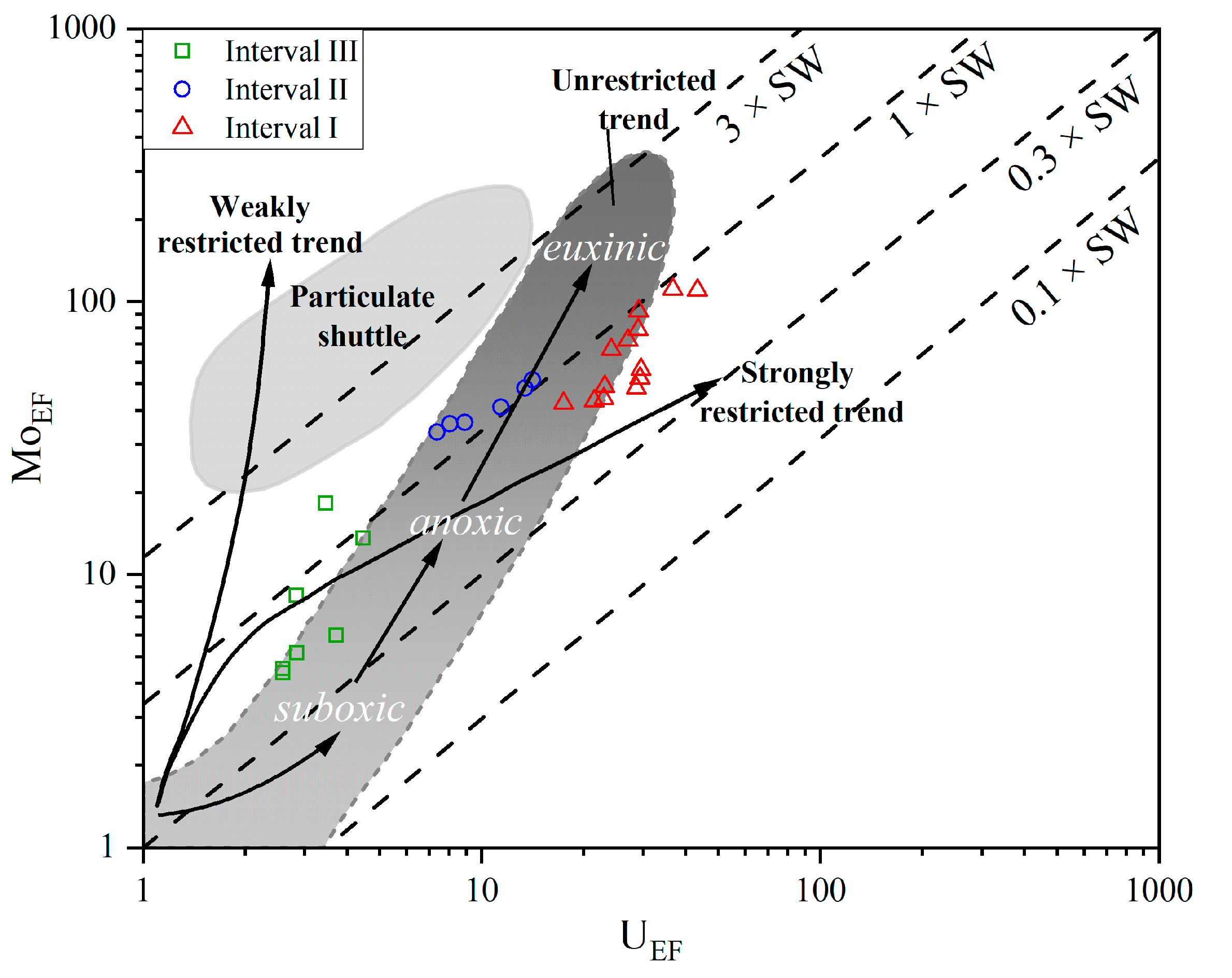
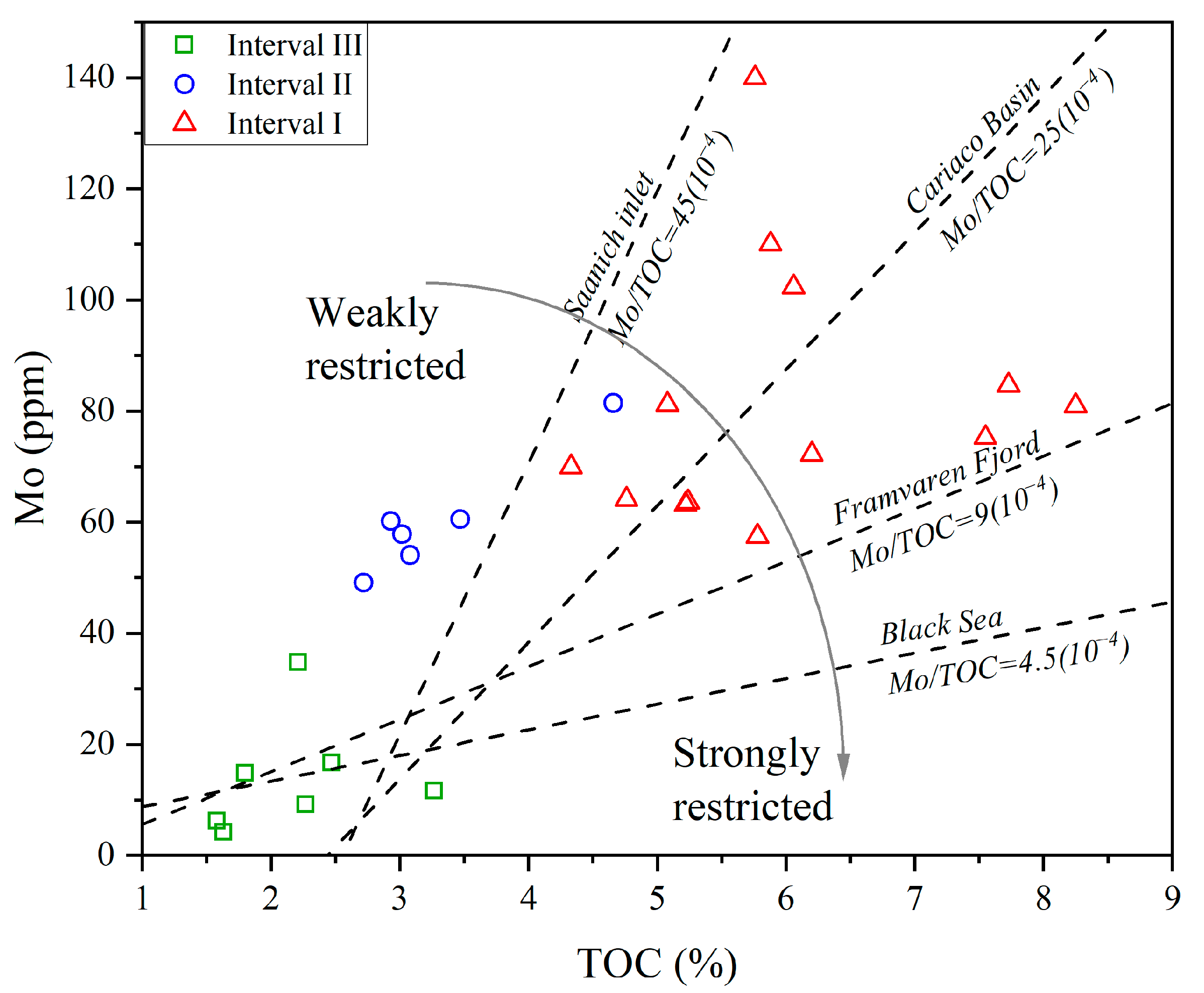
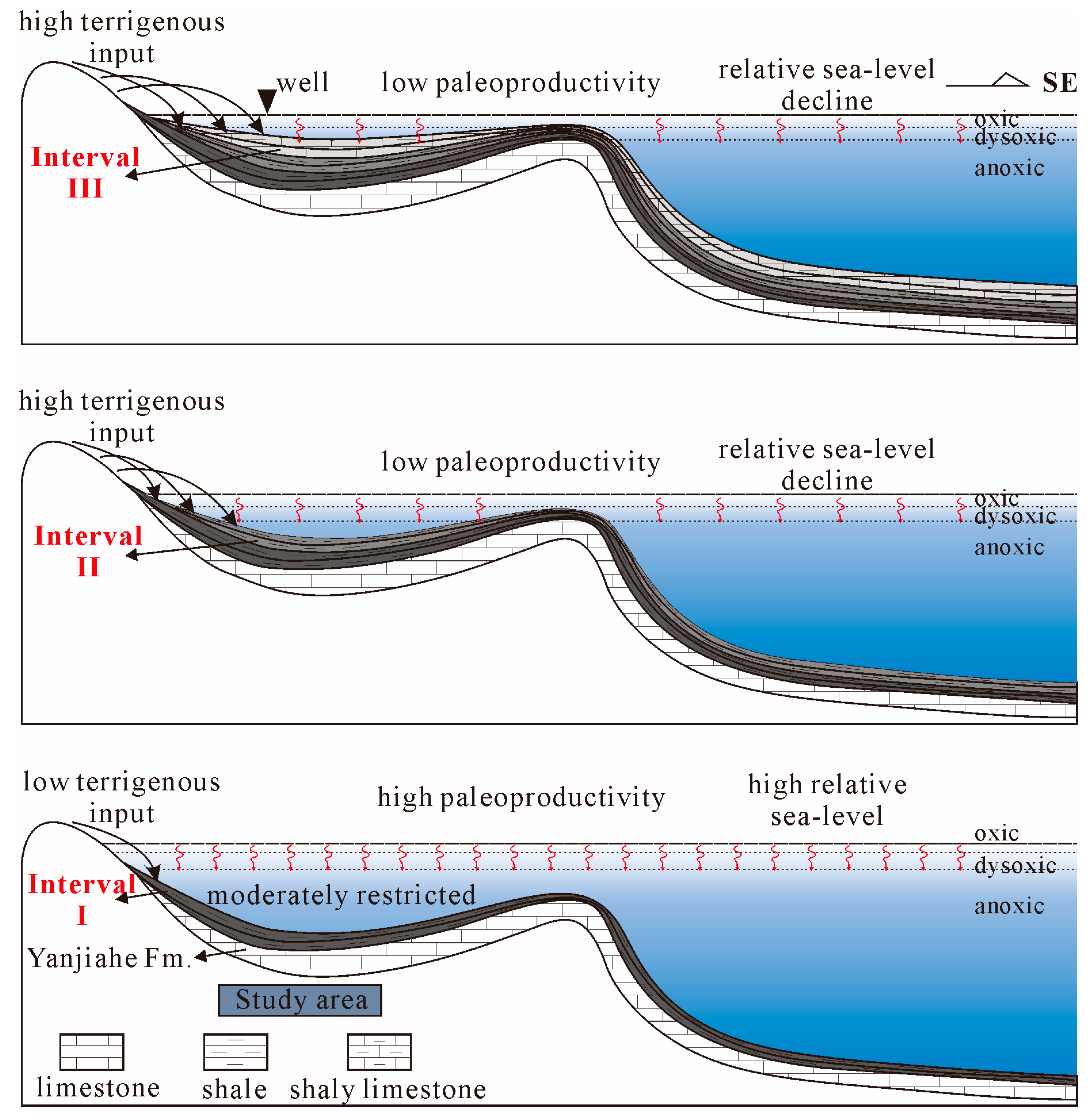
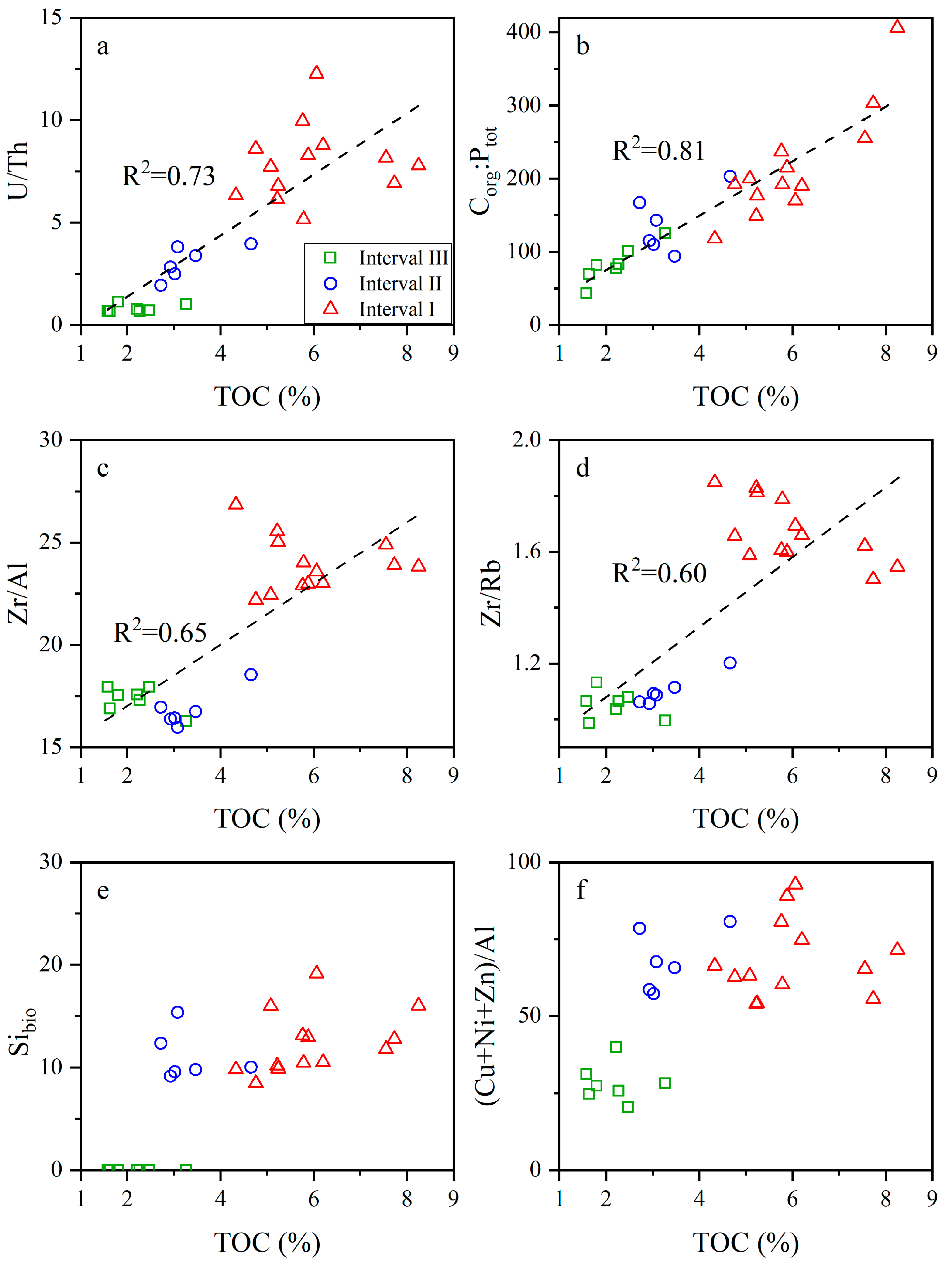
| Depth (m) | Interval | TOC (wt.%) | Lithofacies | Al2O3 (%) | SiO2 (%) | CaO (%) | TiO2 (%) | Fe2O3 (%) | MnO (%) | P2O5 (%) | Th (ppm) | U (ppm) | Mo (ppm) | Cu (ppm) | Ni (ppm) | Zn (ppm) | Zr (ppm) | Rb (ppm) |
|---|---|---|---|---|---|---|---|---|---|---|---|---|---|---|---|---|---|---|
| 2975.53 | III | 1.63 | calcareous S. * | 6.21 | 31.47 | 25.75 | 0.28 | 3.45 | 0.06 | 0.08 | 5.35 | 3.6 | 4.2 | 22.8 | 26.4 | 32.0 | 55.6 | 56.4 |
| 2978.08 | III | 1.58 | calcareous S. | 7.73 | 29.35 | 22.56 | 0.36 | 4.76 | 0.07 | 0.11 | 7.12 | 4.9 | 6.2 | 26.4 | 33.7 | 67.2 | 73.5 | 69.0 |
| 2983.63 | III | 2.47 | clay-rich siliceous S. | 12.81 | 59.62 | 4.87 | 0.61 | 3.32 | 0.02 | 0.09 | 11.4 | 8.0 | 16.7 | 44.0 | 45.7 | 48.3 | 122.0 | 113.0 |
| 2984.98 | III | 2.21 | clay-rich siliceous S. | 12.21 | 60.80 | 4.98 | 0.57 | 3.25 | 0.02 | 0.10 | 12.00 | 9.4 | 34.8 | 60.1 | 83.2 | 114 | 114.0 | 110.0 |
| 2989.32 | III | 1.80 | calcareous S. | 7.00 | 40.68 | 19.32 | 0.31 | 3.90 | 0.05 | 0.08 | 6.10 | 6.9 | 14.9 | 30.7 | 33.1 | 37.4 | 65.0 | 57.4 |
| 2994.23 | III | 3.27 | clay-rich siliceous S. | 12.47 | 55.15 | 5.61 | 0.53 | 4.64 | 0.04 | 0.11 | 10.20 | 10.3 | 11.6 | 58.5 | 46.4 | 80.8 | 107.0 | 108.0 |
| 2996.32 | III | 2.27 | clay-rich siliceous S. | 13.02 | 60.44 | 2.82 | 0.55 | 4.85 | 0.05 | 0.10 | 11.10 | 7.5 | 9.18 | 60.7 | 44.2 | 72.6 | 119.0 | 112.0 |
| 3003.50 | II | 2.72 | siliceous S. | 9.49 | 68.67 | 3.98 | 0.41 | 2.10 | 0.02 | 0.08 | 8.05 | 15.5 | 49.1 | 87.4 | 107.0 | 200.0 | 85.1 | 80.2 |
| 3004.88 | II | 3.08 | siliceous S. | 7.21 | 68.48 | 5.60 | 0.29 | 2.27 | 0.02 | 0.11 | 5.65 | 21.4 | 54.0 | 66.7 | 113.0 | 78.8 | 60.9 | 56.1 |
| 3007.34 | II | 2.93 | siliceous S. | 10.71 | 65.38 | 2.97 | 0.42 | 3.91 | 0.02 | 0.13 | 7.49 | 21.1 | 60.2 | 81.7 | 119.0 | 131.0 | 92.9 | 88.0 |
| 3007.75 | II | 3.02 | siliceous S. | 10.42 | 65.46 | 3.75 | 0.42 | 2.80 | 0.03 | 0.14 | 7.46 | 18.6 | 57.8 | 79.5 | 106.0 | 130.0 | 90.6 | 83.0 |
| 3008.78 | II | 3.47 | siliceous S. | 9.45 | 63.06 | 5.50 | 0.38 | 2.75 | 0.03 | 0.18 | 7.04 | 23.9 | 60.5 | 86.3 | 116.0 | 126.0 | 83.8 | 75.2 |
| 3011.50 | II | 4.66 | siliceous S. | 10.11 | 65.53 | 3.57 | 0.45 | 2.62 | 0.02 | 0.11 | 7.98 | 31.6 | 81.4 | 77.6 | 118.0 | 236.0 | 99.3 | 82.6 |
| 3020.54 | I | 4.33 | siliceous S. | 9.20 | 62.42 | 5.28 | 0.50 | 3.77 | 0.02 | 0.18 | 7.44 | 47.1 | 69.9 | 37.8 | 127.0 | 159.0 | 131.0 | 70.8 |
| 3023.83 | I | 5.22 | siliceous S. | 9.40 | 63.76 | 4.05 | 0.52 | 3.63 | 0.03 | 0.17 | 7.29 | 44.8 | 63.2 | 28.8 | 151.0 | 88.6 | 127.0 | 69.5 |
| 3024.33 | I | 5.24 | siliceous S. | 9.27 | 62.71 | 4.79 | 0.51 | 3.55 | 0.02 | 0.15 | 6.94 | 47.1 | 63.6 | 30.2 | 142.0 | 93.0 | 123.0 | 67.7 |
| 3026.38 | I | 6.20 | siliceous S. | 8.84 | 62.86 | 5.20 | 0.48 | 2.83 | 0.03 | 0.16 | 6.55 | 57.4 | 72.2 | 32.0 | 148.9 | 169.0 | 108.0 | 64.9 |
| 3030.18 | I | 5.78 | siliceous S. | 8.68 | 62.26 | 4.99 | 0.47 | 3.25 | 0.03 | 0.15 | 6.51 | 33.6 | 57.4 | 31.6 | 145.2 | 100.0 | 110.0 | 61.8 |
| 3034.92 | I | 5.76 | siliceous S. | 8.09 | 66.27 | 3.85 | 0.43 | 3.00 | 0.02 | 0.12 | 6.60 | 65.7 | 140 | 38.0 | 206.0 | 101.0 | 98.1 | 61.1 |
| 3037.53 | I | 4.76 | siliceous S. | 8.54 | 57.55 | 7.26 | 0.46 | 3.67 | 0.03 | 0.12 | 6.30 | 54.2 | 64.1 | 31.8 | 151.9 | 100.0 | 100.0 | 60.6 |
| 3041.33 | I | 5.88 | siliceous S. | 7.64 | 64.59 | 2.89 | 0.40 | 5.96 | 0.02 | 0.14 | 5.94 | 49.2 | 110 | 55.1 | 201.0 | 105.0 | 93.0 | 58.2 |
| 3043.48 | I | 5.08 | siliceous S. | 7.22 | 69.82 | 3.42 | 0.38 | 2.44 | 0.01 | 0.13 | 5.60 | 43.2 | 81.1 | 28.8 | 158.0 | 54.7 | 85.8 | 54.1 |
| 3044.76 | I | 6.06 | siliceous S. | 5.97 | 72.98 | 2.57 | 0.32 | 2.21 | 0.01 | 0.18 | 4.68 | 57.4 | 102 | 29.6 | 185.0 | 78.3 | 74.6 | 44.0 |
| 3053.28 | I | 7.73 | siliceous S. | 8.13 | 65.61 | 2.46 | 0.44 | 3.79 | 0.01 | 0.13 | 6.28 | 43.5 | 84.6 | 36.6 | 136.8 | 65.4 | 103.0 | 68.5 |
| 3053.88 | I | 8.25 | siliceous S. | 6.58 | 68.04 | 3.05 | 0.36 | 2.96 | 0.01 | 0.10 | 5.43 | 42.3 | 80.9 | 32.4 | 153.4 | 63.0 | 83.0 | 53.7 |
| 3054.20 | I | 7.55 | siliceous S. | 8.57 | 64.78 | 2.56 | 0.46 | 3.69 | 0.02 | 0.15 | 6.87 | 56.1 | 75.2 | 35.4 | 173.0 | 88.1 | 113.0 | 69.6 |
Disclaimer/Publisher’s Note: The statements, opinions and data contained in all publications are solely those of the individual author(s) and contributor(s) and not of MDPI and/or the editor(s). MDPI and/or the editor(s) disclaim responsibility for any injury to people or property resulting from any ideas, methods, instructions or products referred to in the content. |
© 2023 by the authors. Licensee MDPI, Basel, Switzerland. This article is an open access article distributed under the terms and conditions of the Creative Commons Attribution (CC BY) license (https://creativecommons.org/licenses/by/4.0/).
Share and Cite
Wei, S.; Hu, M.; He, S.; Yang, W.; He, Q.; Cai, Q.; Li, P. Sedimentary Environment Interpretation and Organic Matter Enrichment of the Lower Cambrian Shuijingtuo Shale in the Yichang Slope, South China: Insight from Sedimentary Geochemical Proxies with Major/Trace Elements. J. Mar. Sci. Eng. 2023, 11, 2018. https://doi.org/10.3390/jmse11102018
Wei S, Hu M, He S, Yang W, He Q, Cai Q, Li P. Sedimentary Environment Interpretation and Organic Matter Enrichment of the Lower Cambrian Shuijingtuo Shale in the Yichang Slope, South China: Insight from Sedimentary Geochemical Proxies with Major/Trace Elements. Journal of Marine Science and Engineering. 2023; 11(10):2018. https://doi.org/10.3390/jmse11102018
Chicago/Turabian StyleWei, Sile, Mingyi Hu, Sheng He, Wei Yang, Qing He, Quansheng Cai, and Ping Li. 2023. "Sedimentary Environment Interpretation and Organic Matter Enrichment of the Lower Cambrian Shuijingtuo Shale in the Yichang Slope, South China: Insight from Sedimentary Geochemical Proxies with Major/Trace Elements" Journal of Marine Science and Engineering 11, no. 10: 2018. https://doi.org/10.3390/jmse11102018
APA StyleWei, S., Hu, M., He, S., Yang, W., He, Q., Cai, Q., & Li, P. (2023). Sedimentary Environment Interpretation and Organic Matter Enrichment of the Lower Cambrian Shuijingtuo Shale in the Yichang Slope, South China: Insight from Sedimentary Geochemical Proxies with Major/Trace Elements. Journal of Marine Science and Engineering, 11(10), 2018. https://doi.org/10.3390/jmse11102018





